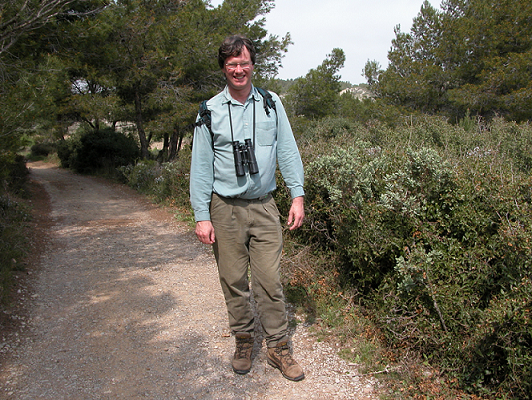
I started birdwatching at 12, leading to a career in the Forestry
Commission where I led on Environment and Recreation. I was a member of
RSPB Council and co-authored the Poyser ‘Birds and Forestry’ with Mark.
Now most of my birdwatching is in a magic valley in the Languedoc
swarming with Nightingale, Turtle Dove, Corn Bunting and Woodlark.
Shifting Baselines
We all know about shifting baselines but what was it really like ? Are our memories simply rose tinted ? Looking through old bird notes I found this account of a walk in perfectly ordinary countryside south of Oxford when I was sixteen.
6 June 1971
It wasn’t a very nice day but a lot of birds were about. I went for a long walk to some gravel workings down by the Thames. In the valley a Cuckoo was cuckooing and a skylark sang from the field next to our garden. In a reedy pond in Radley Park a Grasshopper warbler was reeling and I got a beautiful view of a Turtle Dove which flew out of a tree. A large number of Swifts flew overhead with House Martins. Also in the park I saw a pair of Bullfinches and a Yellowhammer.
On the other side of Radley, wheat fields were full of Yellow wagtails as well as a small flock of Linnets and Goldfinches but the best bird was a Whitethroat carrying food. At the gravel pits there were Pied wagtail, another Whitethroat and about 200 Sand Martin and in the woods nearby a Stock Dove and another Turtle Dove.
On the way home there was another Turtle Dove on the wires but the best bird was a Corn bunting which I saw and heard really well. “

Mark’s BBS square blogs are a good comparator for what you’d see today in a random piece of agricultural countryside. No doubt someone has a patch that could rival my 1971 experience but one certainly won’t find it in a random part of arable England.
[registration_form]
I know the area between Oxford and Radley quite well – frequently cycle and walk there, so maybe a few comparative observations. Cuckoos are still found along the Thames (they occur within the ring-road of Oxford, just), 1-2 Grasshopper Warblers occur most years, and Swifts can still be fairly numerous. House Martins are restricted to a small number of colonies within the city. Whitethroat would be very much expected. Yellowhammer is still reliable on some hedges, as is Linnet, though only ever numerous in the winter. For Corn Bunting these days you’d have to go a little further towards the chalk of the Downs or the Chilterns & Yellow Wagtails are very sparsely spread in Oxfordshire’s agricultural land. No Sand Martins at Radley as far as I know, and Turtle Dove is almost certainly locally extinct. A few species that would be expected on this stretch these days include Cetti’s Warbler, Hobby & Little Egret (and Egyptian Goose!)
Ben – many thanks! The mention of Whitethroat was probably time-dependent as it followed soon after the great Whitethroat crash of 1969 https://app.bto.org/birdtrends/species.jsp?year=2020&s=white and even after about five decades of slow recovery numbers are much lower than the mid 1960s.
Yes – I thought perhaps that was the case. Of course there may also be species that hardly raised a mention in 1971 but which would be completely absent now. Tree Sparrow one & Willow Tit another?
Ben – I’ve only just noticed that you’ve recently been elected to the Royal Society Fellowship. Congratulations!
There are those ( younger than us– isn’t everybody?) of course who will always say we are looking back with rose tinted spectacles. I am a year or three older than Roderick and grew aup in Harrogate, doing most of my early birding between there and Knaresborough as well as in places around Knaresborough. Then it seemed all the fields towards Knaresborough had Grey Partridges, Skylarks were common enough, the wetter fields hosted pairs of Lapwings,and there were a few curlew and Redshank pairs along with hedges full of Whitethroats, finches and buntings. Although it must be said the only raptors we saw were Kestrels and Barn Owls were scarce delights. The Curlew and Redshank went first nearly 50 years ago, the Whitethroat crash of ’69 was never really recovered from as some hedges were lost and farming changed from mixed to pure pasture with the subsequent loss of many of those finches, buntings and larks. The last Partridges were lost there around 2000. Some things have improved the status of our raptors but for huge areas of the countryside and countryside workers the great numbers and variety of our once common farmland birds are barely a remembered shadow on the landscape.
As to the Turtle Dove the last I saw was on Fair Isle in 2019 but on 15th of May 1976 whilst awaiting a cannon net firing at Heacham Beach some 600 flew west along the dunes in a couple of hours according to my notes of the time.
As the Four Yorkshireman sketch ends ” And young folk today just don’t believe you.” Some of course do but they can barely imagine what we have lost in less than a lifetime.
I remember distinctly seeing a Sparrowhawk on a farm visit in Berkshire on a University field trip in 1975. That really was a rareity ! Sadly, my notes prove the point of keeping records – without the word written at the time I wouldn’t have believed my memory.
Thank you for all of these comments, as you say, Roderick, actual dated note-keeping is the best record… thank you for keeping yours, though it does make for rather dismal reading today.